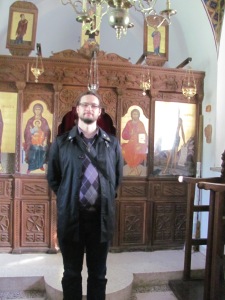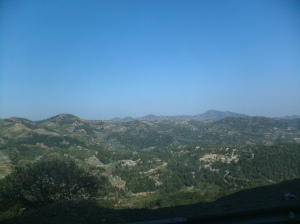I’ve mentioned before that at my Anglican parish, we have a good amount of stained glass, much of it depicting our Lord and Saviour Jesus Christ. This physical space provides a certain head space, and I am grateful for it. In most places I turn, I am struck with a reminder of Jesus, the God-Man who became incarnate to save us, such as the trio below, St. Thomas (our patron) flanked by the Christ:
The stained glass windows serve as a visual reminder of what we’re at church to do — to worship Christ our God. It helps us gain and maintain reverence. As I say, it has an impact upon how we worship.
This is in contrast to St Columba’s Free Church of Scotland where I worshipped in Edinburgh, a building with no stained glass, no images, nothing of that sort. It still had a Victorian Gothic beauty, but a beauty undistracted by figural ornamentation. Here, the focus was on the word as heard in the big Bible on the pulpit, as preached by the teaching elders, as sung in the Psalms. The beautiful, relatively simple, space of the Free Church helped with that focus.
Each is good in its own way.
In Cyprus, I met a third way that is parallel to my Anglican upbringing, at times touching it. Throughout the Troodos Mountains of Cyprus you will find a series of churches that form a UNESCO World Heritage Site. Their interiors (and one interior!) are adorned with frescoes from the late Byzantine/Venetian era, sometimes early Ottoman. Centuries old, these images depict not only Christ, but his saints as well.
When I visited these churches with my friend Fr. Ioannis, himself an iconographer, he explained that an Orthodox Church such as these (see also St John’s Cathedral in Nicosia) are covered in images of the saints because we do not worship alone. These frescoes represent the Great Cloud of Witnesses of Hebrews 11. And on the walls of the apse of many Orthodox churches, they have icons of Sts John Chrysostom, Basil of Caesarea, and Gregory the Theologian (of Nazianzus) to remind the priest that he is concelebrating holy communion with the Fathers.
These three traditions have all shaped the way I worship God. Having grown up Anglican and worshipped in churches with at least one stained window of Christ most of my life, He is enthroned in my heart as God and King and Lord of All. Having spent years with the Wee Frees, I have learned to attune my heart to the God who is beyond all images and sights, to His Word as proclaimed and sung, seeping into my heart (like a Cistercian of old). And having been in and out of Orthodox churches for the past 19 years, I have learned to keep the saints in mind, that great cloud of witnesses surrounding me at prayer, praise, worship.
These questions are permeating my mind a lot right now because I’m preparing to teach “Early Christian Worship: Ritual and Space in the Ancient Church.” I didn’t simply want to do a course on liturgical texts. I wanted to seek out a way to help students sink their teeth, hearts, minds, wills into the material of ancient worship and thence go deeper and meet the one, true, and living God in the heritage of our Church, in the life of ancient faith.
- How did coming from the Temple to the assembly of saints affect the early church?
- How did “house” churches affect worship? (What does that mean?)
- What went on in the catacombs?
- How did they adorn their earliest edifices?
- How does worship in a Christian basilica differ from in a pagan temple?
This is one angle you’ll get to explore with me! So sign up today!











